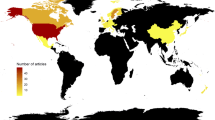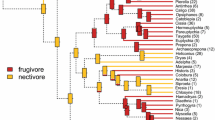Abstract
In natural populations of Thymus vulgaris in the south of France, six genetically different chemical “chemotypes” occur, each differentiated by a single dominant monoterpene that gives individual plants a characteristic smell and taste. Individual populations may contain all six chemotypes, but are often dominated by one to three chemotypes. We tested the hypothesis that this chemical polymorphism was associated with selective herbivory by the snail Helix aspersa, which feeds upon T. vulgaris in nature. The relative preference of juvenile and adult molluscs was investigated by presenting individual animals with a choice of six chemotypes in three experimental trials: (1) whole plants, (2) nutritive gels containing crushed thyme leaves, and (3) nutritive gels containing a distilled monoterpene as an additive. We found significant and consistent patterns of preference. Adult and immature molluscs preferred the linalol chemotype, and ate carvacrol and thymol-containing foods the least. This preference was more marked when using the gels than the real plants, particularly the monoterpene-based gels, demonstrating the importance of the monoterpene for the choice. Furthermore, molluscs fed exclusively on linalol-containing food gained weight whereas those fed on carvacrol-containing food lost weight. After being fed these exclusive diets both groups showed a significant preference for linalol. These results (1) demonstrate that food choice is based upon the presence of specific monoterpenes and is not learned, (2) suggest that phenolic monoterpenes such as carvacrol are repellent to the animals, and (3) indicate that selective herbivory may play a significant role in the maintenance of the chemical polymorphism of T. vulgaris.
Similar content being viewed by others
References
Bryant JP, Provenza FD, Pastor J, Reichart PB, Claussen TP, du-Toit JJ (1991) Interaction between woody plants and browsing mammals mediated by secondary metabolites. Annu Rev Ecol Syst 22:431–436
Buchsbaum R, Valiela I, Swain T (1984) The role of phenolic compounds and other plant constituents in feeding by Canada geese in a coastal marsh. Oecologia 63:343–349
Crawley MJ (1983) Herbivory. University of California Publications, Berkeley
Denno RF, McClure MS (eds) (1983) Variable plants and herbivores in natural and managed systems. Academic Press, New York
Dirzo R, Harper JL (1982) Experimental studies on slug-plant interactions. III. Differences in the acceptability of individual plants of Trifolium repens to slugs and snakes. J Ecol 70:101–118
Fritz RS, Simms EL (1992) Plant resistance to herbivores and pathogens. Chicago Press, Chicago
Gleizes M (1976) Biologie des terpènes végétaux: étude des composés monoterpéenigues et sesqui terpéniques. Année Biol 15: 7–127
Gouyon PH, Jaoul R, Maladiere H, H Milhomme M, Vernet P (1981) Introduction automatique d'échantillons solides dans un chromatographe. Analysis 9:305–310
Gouyon PH, Fort P, Caraux G (1983) Selection of seedlings of Thymus vugaris by grazing slugs. J Ecol 71:288–306
Gouyon PH, Vernet P, Guillerm JL, Valdeyron G (1986) Polymorphisms and environment: the adaptive value of the oil polymorphisms in Thymus vulgaris L. Heredity 57:59–66
Granger R, Passet J (1973) Thymus vulgaris spontané de France: races chimiques et chemotaxonomie. Phytochemistry 12: 1683–1691
Harborne JB, Tomas Barbera EA (eds) (1991) Ecolepical chemistry and biochemistry of plant terpenoids. Clarendon, Oxford
Hay ME, Fenical W (1988) Marine plant-herbivore interactions. Annu Rev Ecol Syst 19:111–125
Hay ME, Steinberg PH (1992) The chemical ecology of plant-herbivore interactions in marine versus terrestrial communities. In: Rosenthal GA, Berenbaum MR (eds) Herbivores: their interactions with secondary plant metabolites, 2nd edn, vol II. Evolutionary and ecological processes. Academic Press, New York, pp 371–413
Jones DA (1962) Selective eating of the acyanogenic form of the plant Lotus corniculatus L. by various animals. Nature 193: 1109–1110
Levin DA (1976) The chemical defenses of plants to pathogens and herbivores. Annu Rev Ecol Syst 7:121–159
Linhart YB (1991) Disease, parasitism and herbivory: multidimensional challenges to plant evolution. Trends Ecol Evol 6: 392–396
Maddox GD, Root RB (1990) Structure of the encounter between goldenrod (Solidago altissima) and its diverse insect fauna. Ecology 71:2115–2124
Marpeau A, Walters J, Launay J, Chason J, Baradat P, Gleizes M (1989) Effects of wounds on the teprene content of tips of maritime pine (Pinus pinaster A.t.) Trees 4:220–226
Marquis, R (1991) Evolution of resistance in plants to herbivores. Evol Trends Plants 5:23–29
Mazzoni C, Gouyon PH (1985) Horizontal structure of populations migration adaptation and chance. An experimental study of Thymus vulgaris. In: Jacquard P, Heim G, Antonovics J (eds) Genetic differentiation and dispersal in plants. Springer, Berlin Heidelberg New York
Mihaliak CA, Couvet D, Lincoln DE (1989) Genetic and environmental contributions to variation in leaf mono- and sesquiterpenes of Heterotheca subaxillaris. Biochem Syst Ecol 17: 528–533
Mitton JB, Sturgeon KB (eds) (1982) Bark beetles of North American Conifers. University of Texas Press, Austin
Paul VJ (ed) (1992) Ecological roles for marine secondary metabolites. Cornell University Press, Ithaca
Pellecuer J, Allegrini J, Simeon de Bouchberg S (1976) Huiles essentielles bactericides et fongicides. Rev Inst Pasteur Lyon 9: 135–159
Price PW (1983) Hypotheses on organization and evolution in herbivorous insect communities. In: Denno RF, mcclure MS (eds) Variable plants and herbivores in natural and managed systems. Academic Press, New York, pp 559–596
Rhoades DF, Cates RG (1976) Toward a general theory of plant antiherbivore chemistry. Recent Adv Phytochem 10:168–213
Simms EL, Fritz RS (1990) The ecology and evolution of host plant resistance to insects. Trends Ecol Evol 5:356–360
Snyder MA (1992) Selective herbivory by Abert's squirrel related to chemical and physiological variability in ponderosa pine. Ecology 73:1730–1741
Sokal RR, Rohlf FJ (1981) Biometry, 2nd edn. Freeman, San Francisco
Stahl E (1888) Pflanzen und Schnecken. Biologische Studié über die Schutzmittel der Pflanzen gegen Schneckenfrass. Jena Z Med Naturwiss 22:557–684
Strong DR, Lawton IH, Southwood R (1984) Insects on plants. Blackwell, Oxford
Tarayre M, Thompson JD, Escarre J, Linhart YB (1995) Intra-specific variation in the inhibitory effects of Thymus vulgaris (labiaceae) monoterpenes on seed germination. Oecologia 101:110–118
Vernet P, Guillerm JL, Gouyon PH (1977a) Le polymorphisme chimique de Thymus vulgaris L. I. Répartition des formes chimiques en relation avec certains facteurs écologiques. Oecol Plant 12:159–179
Vernet P, Guillerm JL, Gouyon PH (1977b) Le polymorphisme chimique de Thymus vulgaris L. II. Carte à l'échelle 1/25,000e des formes chimiques dans la région de St.-Martin-de-londres (Héraut, France). Oecol Plant 12:181–194
Vernet P, Gouyon PH, Valdeyron G (1986) Genetic control of the oil content in Thymus vulgaris L.: a case of polymorphism in a biosynthetic chain. Genetika 69:227–231
Vokou D, Margaris NS (1982) Volatile oils as allelopathic agents. In: Margaris NS, Koedam A, Vokou D (eds) Aromatic plants: basic and applied aspects. Martinus Nijhoff, The Hague, pp 59–72
Vokou D, Margaris NS (1986) Autoallelopathy of Thymus capitatus. Acta Oecol 7:157–163
Whelan RJ (1982a) Response of slugs to unacceptable food items. J Appl Ecol 19:79–87
Whelan RJ (1982b) An artificial medium for feeding choice experiments with slugs. J Appl Ecol 19:89–94
Author information
Authors and Affiliations
Rights and permissions
About this article
Cite this article
Linhart, Y.B., Thompson, J.D. Terpene-based selective herbivory by Helix aspersa (Mollusca) on Thymus vulgaris (Labiatae). Oecologia 102, 126–132 (1995). https://doi.org/10.1007/BF00333320
Received:
Accepted:
Issue Date:
DOI: https://doi.org/10.1007/BF00333320




